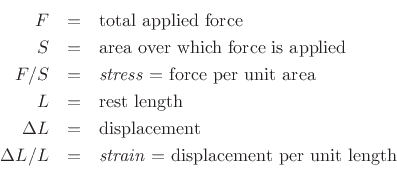Young's modulus can be thought of as the spring constant
for solids. Consider an ideal rod (or bar) of length ![]() and
cross-sectional area
and
cross-sectional area ![]() . Suppose we apply a force
. Suppose we apply a force ![]() to the face of
area
to the face of
area ![]() , causing a displacement
, causing a displacement ![]() along the axis of the rod.
Then Young's modulus
along the axis of the rod.
Then Young's modulus ![]() is given by
is given by

where

For wood, Young's modulus ![]() is on the order of
is on the order of ![]() N/m
N/m![]() .
For aluminum, it is around
.
For aluminum, it is around ![]() (a bit higher than glass which is near
(a bit higher than glass which is near
![]() ), and structural steel has
), and structural steel has
![]() [181].
[181].